多路波形发生器的设计说明
虚拟仪器设计说明书--多路信号发生器
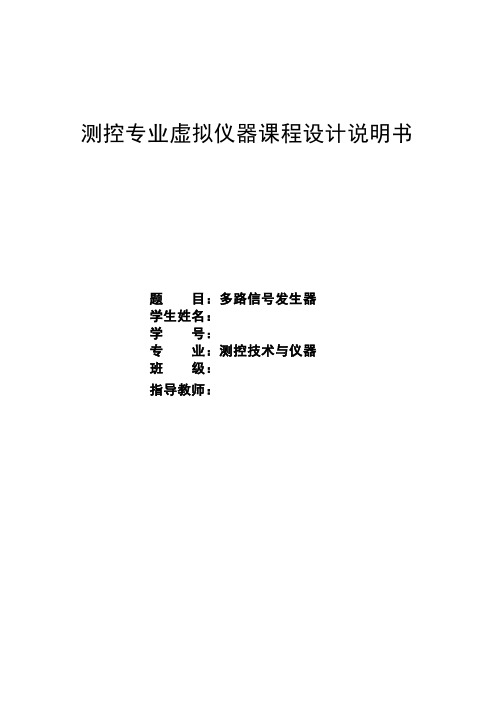
测控专业虚拟仪器课程设计说明书题目:多路信号发生器学生姓名:学号:专业:测控技术与仪器班级:指导教师:1.设计题目:多路信号发生器2. 设计目的:1.通过实验让我们更深入了解虚拟仪器的基本原理及观念,掌握利用相关的软、硬件平台完成虚拟仪器设计的方法和步骤。
2.了解虚拟仪器的具体的实际应用。
3. 将所学的知识通过设计信号发生器实验可产生各种波形如正弦波、方波、三角波、锯齿波等;来加深对虚拟仪器技术的深层理解。
3.设计要求:①可输出双路正弦波(方波、三角波)信号,其相位差可调②信号频率、幅值、占空比可调4.基本设计思路:在条件结构中运用“基本函数发生器”模块作为正弦波、方波、三角波信号的发生单元,通过其可设置频率、幅值、相位差及占空比的调节,且经过条件结构即可进行双路、单路等各信号输出的选择,然后用While循环使输出信号连续的动起来,所产生的信号通过波形图来显示,可用DAQ输入模块将信号送入数据采集卡PCI6221再用DAQ输出模块将信号采集回来用波形图显示,便可验证所产生的信号,或通过示波器来验证!5.程序流程图:图1.程序流程图6.设计实现过程:(1)通过“条件结构”来分配通道在程序框图中,右键在编程—结构中如图,即可拖出条件结构,,此条件结构通过设置条件分支来进行通道1、2各种波形信号的选择。
条件分支的设置可在前面板输入控件中选择“滑动杆”连入分支选择中,对其进行属性设置得到通道选择如下图作为所产生波形通道的选择。
在真假选择中通过右键增加输入分支分别为0、1、2、3,对应通道1、2、双通道及公式波形。
将基本函数发生器及其类型放条件结构内,其他输入控件放条件外,以供个条件连线方便使用。
(2)“基本函数发生器”模块及基本参数设置在程序框图中右键选择信号处理如下图(a),选中波形生成找到基本函图(a)数发生器共调用两个,此模块放条件结构内用于产生正弦波、方波、三角波等;“基本函数模块”基本参数设置:在前面板中,击右键,从Express中的数值输入控件中,选择旋钮输入控件,并将其拖入前面板中,之后,按住Ctrl键不放,一次拖动复制八个旋钮(如图(b)),并分别命名为“频率1”、“幅值1”、“幅值2”、“占空比1”、“相位1”,“相位2”、“偏移量1”、“偏移量2”(控制波形的上下平移)尤其是信号类型的输入控件,其中已经包含三角、方波、正弦波、锯齿波,若需要可通过属性中编辑项插入来添加各种波形。
VHDL多路波形发生器实验报告
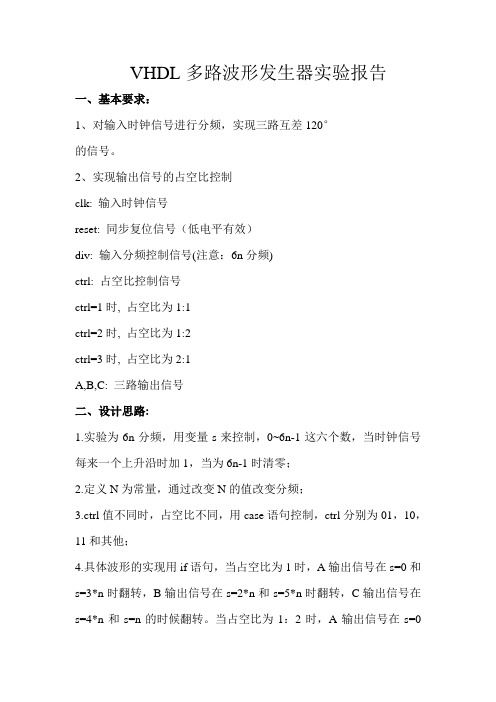
VHDL多路波形发生器实验报告一、基本要求:1、对输入时钟信号进行分频,实现三路互差120°的信号。
2、实现输出信号的占空比控制clk: 输入时钟信号reset: 同步复位信号(低电平有效)div: 输入分频控制信号(注意:6n分频)ctrl: 占空比控制信号ctrl=1时, 占空比为1:1ctrl=2时, 占空比为1:2ctrl=3时, 占空比为2:1A,B,C: 三路输出信号二、设计思路:1.实验为6n分频,用变量s来控制,0~6n-1这六个数,当时钟信号每来一个上升沿时加1,当为6n-1时清零;2.定义N为常量,通过改变N的值改变分频;3.ctrl值不同时,占空比不同,用case语句控制,ctrl分别为01,10,11和其他;4.具体波形的实现用if语句,当占空比为1时,A输出信号在s=0和s=3*n时翻转,B输出信号在s=2*n和s=5*n时翻转,C输出信号在s=4*n和s=n的时候翻转。
当占空比为1:2时,A输出信号在s=0和s=2*n时翻转,B输出信号在s=2*n和s=4*n时翻转,C输出信号在s=4*n和s=0的时候翻转。
当占空比为2:1时,A输出信号在s=0和s=4*n时翻转,B输出信号在s=2*n和s=0时翻转,C输出信号在s=4*n和s=2*n的时候翻转;5.在占空比为1和1:2时,C输出信号应比B慢120度,但是实际输出超前B,所以要对C输出进行反相;同理,在占空比为2:1时,要对B、C分别进行反向。
6.用if语句判断是否复位,若非,则执行case语句。
三、流程图:四、源程序library ieee;use ieee.std_logic_1164.all;use ieee.std_logic_arith.all;use ieee.std_logic_unsigned.all;entity top isport(clk,reset:in std_logic;ctrl:in std_logic_vector(1 downto 0);A,B,C:out std_logic);end top ;architecture rel of top issignal temp1,temp2,temp3,temp4,temp5 : std_logic; constant N: integer:=1;signal s:integer range 0 to 6*N-1 ;beginprocess(clk,reset,ctrl)beginif (reset='0') thentemp1<='0';temp2<='0';temp3<='0';temp4<='0';temp5<='0';s<=0;elsecase ctrl iswhen "01"=>if (clk 'event and clk='1') thenif s=6*N-1 thens<=0;elses <= s+1;end if;if s=0 thentemp1<= not temp1;end if;if s=3*N thentemp1<= not temp1;end if;if s=2*N thentemp2<= not temp2;end if;if s=5*N thentemp2<= not temp2;end if;if s=4*N thentemp4<= not temp4;end if;if s=N thentemp4<= not temp4;end if;end if;temp3<= not temp4;when "10"=>if (clk 'event and clk='1') thenif s=6*N-1 thens<=0;elses <= s+1;end if;if s=0 thentemp1<= not temp1;end if;if s=2*N thentemp1<= not temp1;end if;if s=2*N thentemp2<= not temp2;end if;if s=4*N thentemp2<= not temp2;end if;if s=4*N thentemp4<= not temp4;end if;if s=0 thentemp4<= not temp4;end if;end if;temp3<= not temp4;when "11"=>if (clk 'event and clk='1') thenif s=6*N-1 thens<=0;elses <= s+1;end if;if s=0 thentemp1<= not temp1;end if;if s=4*N thentemp1<= not temp1;end if;if s=2*N thentemp5<= not temp5;end if;if s=0 thentemp5<= not temp5;end if;if s=4*N thentemp4<= not temp4;end if;if s=2*N thentemp4<= not temp4;end if;end if;temp2<= not temp5;temp3<= not temp4;when others=>temp1<='0';temp2<='0';temp3<='0';end case;end if;end process;A<=temp1;B<=temp2;C<=temp3;end rel;五、仿真波形:整体波形:当ctrl=1 当ctrl=2 当ctrl=3复位当ctrl=其他:六、实验过程遇到的问题:在程序设计时,开始不知该怎样使A,B,C互差120度,开始是想通过定义一个变量,每来一个上升沿加1,从0开始,A路信号除3n 取余为0则翻转,B路信号除3n取余为1则翻转,C路信号除3n取余为2则翻转,我觉得这样的想法应该没有错,可是实际却调不出来,可能是某处逻辑有问题,后来就模仿老师给的6分频程序,设计了现在的程序。
多波形信号发生器的设计 -回复

多波形信号发生器的设计-回复多波形信号发生器的设计。
第一步:理解多波形信号发生器的概念和原理多波形信号发生器是一种电子设备,用于生成不同波形的信号。
这些信号可以是正弦波、方波、三角波、锯齿波等,并且可以在不同的频率范围内进行调节。
多波形信号发生器在电子测试和测量、音频设备等领域中具有广泛的应用。
第二步:确定设计要求和功能在设计多波形信号发生器之前,我们需要确定所需的设计要求和功能。
这包括频率范围、输出幅度调节范围、波形选择和切换等。
同时,还需要考虑设备的可靠性、稳定性和可控性。
第三步:选择合适的电路拓扑结构根据设计要求和功能,可以选择合适的电路拓扑结构。
常见的多波形信号发生器电路包括集成电路实现的数字波形生成器和基于模拟电路的波形发生器。
集成电路实现的数字波形生成器通常使用数字信号处理器(DSP)或可编程逻辑器件(FPGA)来生成不同的波形。
这种方式具有较高的灵活性和精确性,但也需要较高的设计和调试成本。
基于模拟电路的波形发生器通常使用运算放大器、晶体管和电容器等基本器件来实现。
不同波形的发生可以通过改变电路中的电阻、电容和电压等参数来实现。
这种方式相对简单,但仍需注意电路的稳定性和精度。
第四步:设计电路图和PCB 布局根据选定的电路拓扑结构,可以开始设计电路图和PCB 布局。
电路图要包括全部的电路连接和元器件数值。
在布局时,需要注意各电路模块之间的信号干扰和互相影响,合理分配元器件的位置和布线。
第五步:选择适当的元器件和芯片在设计中,需要根据电路参数和性能要求来选择适当的元器件和芯片。
这包括运算放大器、晶体管、电容器、电阻器等。
需要选择具有稳定性和可靠性的元器件,并在性能和价格方面进行权衡。
第六步:PCB 制造和焊接设计完成后,可以将电路图和PCB 布局文件交给PCB 制造商进行制造。
制造完成后,需要进行焊接并完成设备的组装。
第七步:测试和调试在完成设备组装后,需要进行测试和调试。
这包括检查电路连接和元器件的正确性,检查电路各模块之间的信号传递情况,并进行波形输出和参数测试。
多波形信号发生器的设计
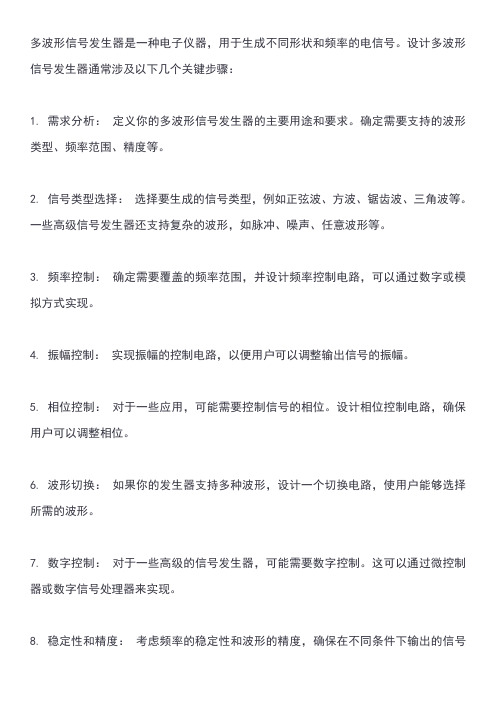
多波形信号发生器是一种电子仪器,用于生成不同形状和频率的电信号。
设计多波形信号发生器通常涉及以下几个关键步骤:
1. 需求分析:定义你的多波形信号发生器的主要用途和要求。
确定需要支持的波形类型、频率范围、精度等。
2. 信号类型选择:选择要生成的信号类型,例如正弦波、方波、锯齿波、三角波等。
一些高级信号发生器还支持复杂的波形,如脉冲、噪声、任意波形等。
3. 频率控制:确定需要覆盖的频率范围,并设计频率控制电路,可以通过数字或模拟方式实现。
4. 振幅控制:实现振幅的控制电路,以便用户可以调整输出信号的振幅。
5. 相位控制:对于一些应用,可能需要控制信号的相位。
设计相位控制电路,确保用户可以调整相位。
6. 波形切换:如果你的发生器支持多种波形,设计一个切换电路,使用户能够选择所需的波形。
7. 数字控制:对于一些高级的信号发生器,可能需要数字控制。
这可以通过微控制器或数字信号处理器来实现。
8. 稳定性和精度:考虑频率的稳定性和波形的精度,确保在不同条件下输出的信号
质量始终保持在可接受的水平。
9. 输出电路:设计一个适当的输出电路,确保信号可以以合适的电平输出,同时避免信号失真。
10. 校准和测试:在最终设计中包括校准电路,以确保信号发生器的输出与预期值一致。
进行必要的测试,以验证性能。
在设计多波形信号发生器时,需要充分了解电子电路设计、信号处理、数字电路和控制系统等相关知识。
此外,确保符合相关的电磁兼容性(EMC)和安全标准,以确保设备的正常运行和用户的安全。
多种波形发生器的设计

《电子技术》课程设计说明书题目名称:多种波形发生器的设计姓名:xxx学号:xxx班级:xxx指导教师:xxx2013年 1 月 4 日摘要波形发生器是一种能够产生大量标准信号和用户定义信号,具有高精度、可重复性、易操作性、对频率、幅值、相移、波形进行动态及时的控制的一类新型信号源。
本设计的设计方案是把滞回比较器和积分器首尾相接组成一个正反馈闭环系统,则比较器输出的方波经过积分器可得到三角波,三角波又触发比较器自动翻转形成法波;三角波—正弦波的转换电路主要由差分放大电路来完成,差分放大电路具有工作点稳定,输入阻抗高,抗干扰能力强等优点。
特别是作为直流放大器,可以有效抑制零点漂移,因此可以将频率很低的三角波变换成正弦波。
波形变换的原理是利用差分放大器传输特性曲线的非线性。
关键词:信号源;滞回比较器;积分器;波形发生器多种波形发生器的设计背景波形发生器是随着众多领域对于复杂的、可由用户定义的测试波形的需要而形成和发展起来的,它的主要特点是可以产生任何一种特殊波形,输出信号的频率、电平以及平滑低通滤波的截至频率也可以作到程序设置,因此在机械性能分析、雷达和导航、自动测试系统等方面得到广泛的应用。
而对AWG的控制、数据传输、输出信号的频率和电平设置都可以通过微机打印口在EPP工作模式下设计完成。
这样不仅具有设计简单,占用微机资源较少的优点,而且操作简单,使用方便,易于硬件升级。
波形发生器是能够产生大量的标准信号和用户定义信号,具有高精度、可重复性、易操作性、连续的相位变换和频率稳定性,还可以对频率、幅值、相移、波形进行动态及时的控制。
随着不断进步的计算机技术和微电子技术在测量仪器中的应用而形成和发展起来的一类新型信号源。
目录1.摘要 (2)1.设计目的 (4)2.设计任务、要求及设计容 (4)2.1任务 (4)2.2要求 (4)2.3设计方案 (5)3. 多种波形发生器原理电路设计 (5)3.1各方案原理框图及论证 (5)3.2电路图和接线图及工作原理 (6)3.3各部分电路设计 (8)3.4 电路的参数选择及计算 (13)3.5电路仿真 (15)3.6系统仿真结果、数据分析和处理结果、报告 (17)3.7 方波---三角波发生电路的实验结果 (19)3.8三角波---正弦波发转换电路的实验结果 (19)3.9 实测电路波形、误差分析及改进方法 (20)4. 仪器仪表明细清单 (20)5.总结 (21)6. 主要参考文献 (21)一、设计目的(1)对波形的产生及与变换电路有关的电子电路知识有大致的理解。
多路波形发生器的制作与调试实验报告

姓名学号:班级:院系:2014年4月3日多路波形发生器的制作与调试实验报告一、实验名称:PCB板焊接二、实验目的:学会1、使用刮刀和钢模印刷焊锡膏,2、使用镊子将元器件放在PCB板上, 3、使用回流焊机,4、使用调试多路波形发生器电路的波形,5、使用热风枪三、实验内容: 1.印刷焊锡膏2.放置元器件3.回流焊4.调试电路,记录数据5.使用热风枪四、实验环境:实训楼305,刮刀,钢模,回流焊机,稳压源,波形发生器,万用表,镊子,热风枪。
五、实验注意事项: 1.印刷焊锡膏,刮刀应倾斜45度。
2.注意元器件放置的方向。
3.调试电路应接入5V直流电源六、实验步骤1.焊锡膏,刮刀,多路波形发生器钢模准备如图1.1图1.2所示图1.1 刮刀图1.2 焊锡膏将钢模板放在支架上,PCB板放在钢模板的下面,对齐钢模板的窗口,将焊锡膏如图1.2倒在钢模板上(少量),用刮刀如图1.1倾斜45度角由上往下将焊锡膏通过钢模板覆盖在PCB上,做完后,检查PCB的各个焊点上有无覆盖焊锡膏。
2.放置元器件。
在PCB板弄完焊锡膏后,用镊子轻轻地将一个个元器件依次放在PCB板上,检查元器件是否有遗漏。
3.回流焊。
将元器件放置好的PCB板,小心翼翼的放入再流焊机上如图1.3,温度调到230度进行焊接。
图1.3再流焊机多路波形发生器就这样焊好了如图1.4。
图1.4 多路波形发生器4.测试电路。
任务: (1) 用示波器观察Q1、Q2基极波形。
(2)用示波器观察74HC4060 10角波形。
晶振产生信号是什么样的?正弦波还是方波?(3)用万用表测试Q1、Q2、Q3、Q4的Vbe。
将焊好的PCB板用示波器和稳压源测试波形,如图1.5和图1.6所示。
图1.5 示波器图1.6 稳压源先用万用表将稳压源调成5V,将电路板接入5V直流电,红色线接电源,黑色线接地。
示波器接入探头,一端接Q1基极,一端接地,调试示波器参数。
Q1、Q2、Q3、Q4基极波形分别如图所示。
555多路波形发生器的系统功能及设计原理
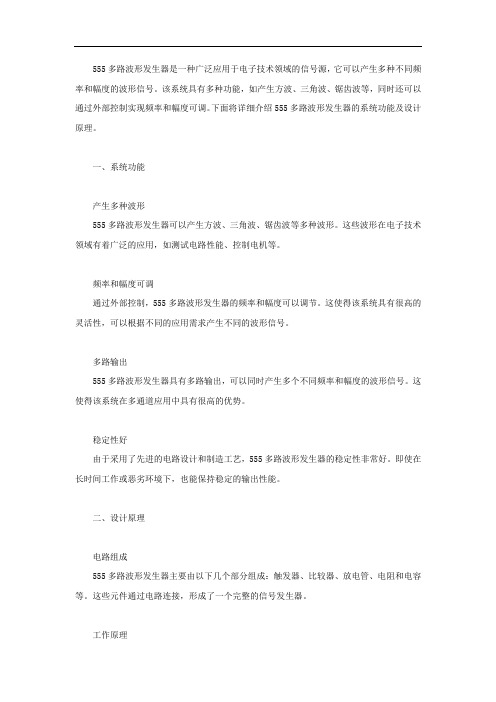
555多路波形发生器是一种广泛应用于电子技术领域的信号源,它可以产生多种不同频率和幅度的波形信号。
该系统具有多种功能,如产生方波、三角波、锯齿波等,同时还可以通过外部控制实现频率和幅度可调。
下面将详细介绍555多路波形发生器的系统功能及设计原理。
一、系统功能产生多种波形555多路波形发生器可以产生方波、三角波、锯齿波等多种波形。
这些波形在电子技术领域有着广泛的应用,如测试电路性能、控制电机等。
频率和幅度可调通过外部控制,555多路波形发生器的频率和幅度可以调节。
这使得该系统具有很高的灵活性,可以根据不同的应用需求产生不同的波形信号。
多路输出555多路波形发生器具有多路输出,可以同时产生多个不同频率和幅度的波形信号。
这使得该系统在多通道应用中具有很高的优势。
稳定性好由于采用了先进的电路设计和制造工艺,555多路波形发生器的稳定性非常好。
即使在长时间工作或恶劣环境下,也能保持稳定的输出性能。
二、设计原理电路组成555多路波形发生器主要由以下几个部分组成:触发器、比较器、放电管、电阻和电容等。
这些元件通过电路连接,形成了一个完整的信号发生器。
工作原理当触发器接收到一个外部信号时,会触发比较器产生一个脉冲信号。
这个脉冲信号通过放电管和电阻电容网络,产生一个具有特定频率和幅度的波形信号。
同时,通过外部控制,可以调节比较器的阈值电压,从而改变波形信号的频率和幅度。
波形生成通过调整放电管和电阻电容网络的参数,可以生成方波、三角波、锯齿波等多种波形。
具体来说,当放电管导通时,电容通过放电管放电,产生一个下降沿;当放电管截止时,电容通过电阻充电,产生一个上升沿。
通过调整放电管和电阻的参数,可以改变上升沿和下降沿的斜率,从而生成不同的波形。
频率和幅度调节通过外部控制,可以调节比较器的阈值电压,从而改变波形信号的频率和幅度。
具体来说,当阈值电压升高时,比较器产生的脉冲信号频率降低;当阈值电压降低时,比较器产生的脉冲信号频率升高。
基于CPLD多波形信号发生器设计说明

第一章绪论1.1研究容及意义高精度的信号源对通信系统、电子对抗以及各种电子测量技术十分重要。
随着电子技术的发展,对信号源频率的准确度、稳定度,以及频谱纯度等方面要求越来越高。
传统的信号发生器由于波形精度低,频率稳定性差等缺点,已经不能满足许多实际应用的需要。
本系统设计的函数发生器是以可编程逻辑器件CPLD为核心,采用直接频率合成技术,通过数模转换电路,构成一个精度较高,波形稳定的函数信号发生器。
较传统的频率合成技术相比,直接频率合成技术(Direct Digital Synthesis,简称DDS),具有频率分辨率高、频率转变速度快、输出相位连续、相位噪声低、可编程和全数字化、便于集成等突出优点,使其得到越来越广泛的应用,成为众多电子系统中不可缺少的组成部分。
在现代电子技术中,信号源在各种实验应用和实验测试处理中应用非常广泛作,为激励源,仿真各种测试信号。
本文根据信号波形的产生特点,采用基于 CPLD/FPGA 的 VHDL 硬件描述语言,仿真实现了多波形发生器的设计。
仿真结果输出较高精度、稳定的波形信号,可以满足测量或各种实际需要,方便、简易实用。
1.2国外研究概况传统的波形发生器多采用模拟电路或单片机或专用芯片,由于成本高或控制方式不灵活或波形种类少不能满足实际需求。
目前市场上的数字信号发生器主要采用直接数字合成技术,这种波形发生器不仅可以产生可变频的载频信号、各种调制信号,同时还能和计算机配合产生用户自定义的有限带宽的任意信号,可以为多领域的测试提供宽带宽、高分辨率的测试信号。
从目前发展状况来看,国外数字信号发生器的研制和生产技术已经较为成熟。
国市场上的波形发生器,其电路形式有采用运放及分立元件构成;也有采用单片集成的函数发生器,而在现代电子系统设计中, DDS技术发展迅速,由于其易于单片集成,积小,价格低,功耗小,因此其应用也越来越广泛。
并且在相对带宽、频率转换时间、高分辨力、相位连续性、正交输出以及集成化等一系列性能指标方面远远超过了传统频率合成技术所能达到的水平,为系统提供了优于模拟信号源的性能。
多路波形发生器的设计与实现

多路波形发生器的设计与实现引言多路波形发生器是一种能够同时输出多种不同信号波形的设备。
它的设计与实现涉及到信号发生器、电路设计以及软件编程等多个方面的知识。
本文将详细探讨多路波形发生器的设计与实现过程。
设计要求在设计多路波形发生器时,需要满足以下要求: 1. 能够同时输出多路信号波形;2. 支持多种常见的信号波形,例如正弦波、方波、三角波等;3. 能够调节不同信号波形的频率、幅度和相位等参数;4. 需要提供友好的用户界面,方便用户进行操作;5. 设备的输出稳定性和精度要求较高。
设计方案基于以上设计要求,我们可以采用以下设计方案来实现多路波形发生器:电路设计模拟信号生成电路1.使用数字模拟转换器(DAC)将数字信号转换为模拟信号;2.通过运放电路放大模拟信号,并根据用户设置的幅度参数进行调节;3.按照用户设置的频率参数生成模拟信号的周期性变化。
控制电路设计1.使用微控制器或FPGA作为控制核心,负责接收用户的输入,控制信号的生成和输出等操作;2.通过按键、旋钮或者触摸屏等输入设备与用户进行交互;3.控制电路还需要生成相位差来实现多路信号波形的同步输出。
软件编程1.使用适当的编程语言开发控制软件,实现用户界面的设计和数据的处理;2.根据用户输入的参数,生成对应的波形参数,并通过控制电路输出;3.控制软件还需要实现相位差的计算和同步输出的控制。
实现步骤下面将介绍具体的实现步骤:步骤一:电路设计与组装1.根据电路设计方案,选择合适的元器件,设计并制作模拟信号生成电路;2.设计并制作控制电路,使其能够与模拟信号生成电路有效地协作;3.对于大规模的多路波形发生器,可能需要使用多个模块进行串联或并联。
步骤二:软件编程与调试1.根据设计方案,使用适当的编程语言进行控制软件的开发;2.实现用户界面的设计,包括输入参数的显示和调节;3.编写波形参数生成的算法,并将生成的参数发送给控制电路;4.调试软件功能及与控制电路之间的通信问题。
深圳大学多种波形发生器的设计与制作(信号发生器)

“三性实验”报告册课程名称:电子技术实验(模电、数电)实验项目名称:多种波形发生器的设计与制作学院:电子科学与技术专业:微电子班级:01报告人:学号:2010160062指导教师:黄海漩实验时间:2012年5月18日提交时间:2012年6月15日实验目的1、本实验的内容是设计和制备一个多种波形发生器,从而掌握集成运算放大器的使用方法,加深对集成运算放大器工作原理的理解。
2、同时也进一步加深对模拟电路中所学知识的掌握和认识,掌握用运算放大器构成波形发生器的设计方法。
3、并通过单元电路的分析,了解电路系统设计的步骤和组合方法。
4、掌握波形发生器电路调试和制作方法,在电路设计中和实验中也需要了解对元器件的选择标准,掌握一些常用元件的性能。
二、实验设计要求(1)可以同时输出正弦、方波、三角波三路波形信号,波形人眼观察无失真。
(2)利用一个按钮,可以切换输出波形信号。
(3)频率为1-2KHz 连续可调,波形幅度不作要求。
三、实验电路的结构分析本实验的内容是设计和制备一个多种波形发生器,整体功能框图如图所示,可以分为正弦波发生器、方波发生器、三角波发生器和比例放大器四大部分。
其中正弦波发生器的功能是产生正弦波,然后通过整形电路将正弦波变换成方波,再由积分电路将方波变成三角波。
设计思路:四、设计方案:1、主要元件清单:2、电路图(可见附录1)3、实验设备:电源、示波器、电烙铁、万用表、电子试验箱4、具体方法、步骤:1)正弦波振荡器如下图所示,正弦波振荡器采用RC桥式振荡器产生一频率可调的正弦信号。
通过开关切换两组电容,改变频率倍率。
R4、R7采用双联线性电位器,便于频率刻度调节,可获得所需要的输出频率。
调整R3可改变正弦波失真度,同时使正弦波趋于稳定。
(图中R1:R2≈2,再通过调节R3,使串联电阻:并联电阻大于等于2,满足起振条件,综合考虑,因此选R1=10k,R2=5.1k,R3=50k可调变阻器)正弦波振荡电路2)如下图所示,由正弦波振荡器产生的一定频率的正弦信号经过比较器产生一同频率的方波。
lm317多路波形发生器原理
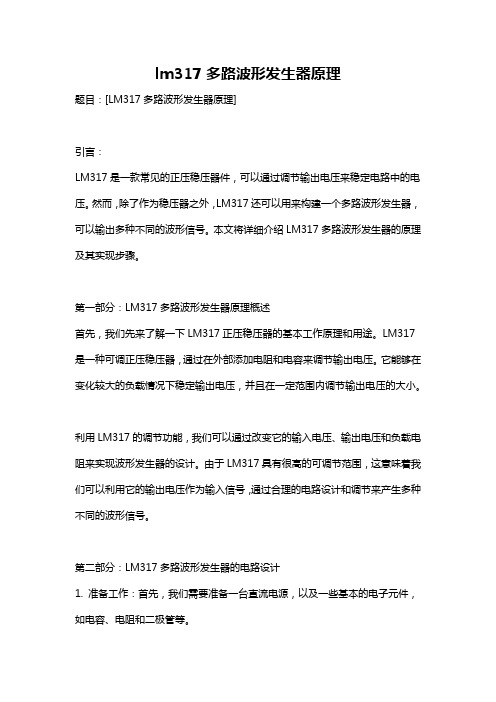
lm317多路波形发生器原理题目:[LM317多路波形发生器原理]引言:LM317是一款常见的正压稳压器件,可以通过调节输出电压来稳定电路中的电压。
然而,除了作为稳压器之外,LM317还可以用来构建一个多路波形发生器,可以输出多种不同的波形信号。
本文将详细介绍LM317多路波形发生器的原理及其实现步骤。
第一部分:LM317多路波形发生器原理概述首先,我们先来了解一下LM317正压稳压器的基本工作原理和用途。
LM317是一种可调正压稳压器,通过在外部添加电阻和电容来调节输出电压。
它能够在变化较大的负载情况下稳定输出电压,并且在一定范围内调节输出电压的大小。
利用LM317的调节功能,我们可以通过改变它的输入电压、输出电压和负载电阻来实现波形发生器的设计。
由于LM317具有很高的可调节范围,这意味着我们可以利用它的输出电压作为输入信号,通过合理的电路设计和调节来产生多种不同的波形信号。
第二部分:LM317多路波形发生器的电路设计1. 准备工作:首先,我们需要准备一台直流电源,以及一些基本的电子元件,如电容、电阻和二极管等。
2. 稳压电路设计:在实现多路波形发生器之前,我们首先需要设计一个稳压电路,例如使用一个LM317稳压器。
根据设计需求,选择合适的输入电压范围和输出电压范围,并根据LM317的数据手册进行电路连接和电阻、电容的选取。
3. 多路输出设计:在稳压电路的基础上,我们可以通过增加多个输出端口来实现多路波形输出。
每个输出端口可以通过外部连线和开关来选择打开或关闭,以实现不同波形的输出。
同时,为了避免输出端口之间的相互影响,可以使用适当的电子元件,如隔离二极管、放大器等。
第三部分:LM317多路波形发生器的实现步骤1. 连接稳压电路:根据电路设计,将稳压电路连接到电源上,并确保输入电压和输出电压符合设计要求。
同时,为了保证稳压电路的可靠性,可以采取适当的保护措施,比如添加稳压电路的输入和输出端口的滤波电容。
555多路波形发生器的系统功能及设计原理 -回复
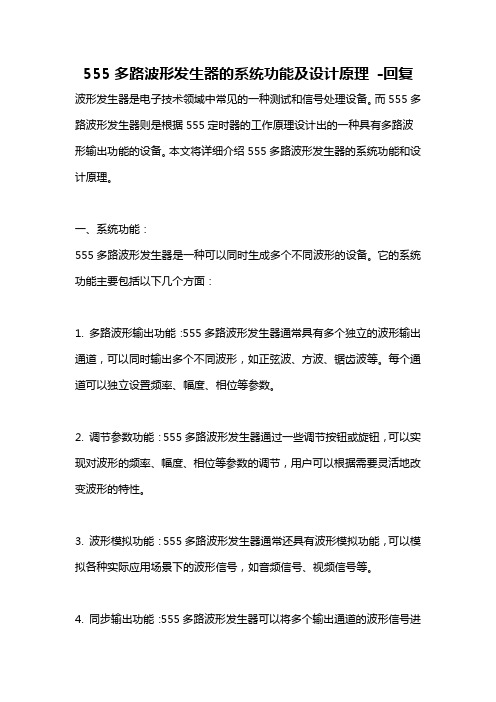
555多路波形发生器的系统功能及设计原理-回复波形发生器是电子技术领域中常见的一种测试和信号处理设备。
而555多路波形发生器则是根据555定时器的工作原理设计出的一种具有多路波形输出功能的设备。
本文将详细介绍555多路波形发生器的系统功能和设计原理。
一、系统功能:555多路波形发生器是一种可以同时生成多个不同波形的设备。
它的系统功能主要包括以下几个方面:1. 多路波形输出功能:555多路波形发生器通常具有多个独立的波形输出通道,可以同时输出多个不同波形,如正弦波、方波、锯齿波等。
每个通道可以独立设置频率、幅度、相位等参数。
2. 调节参数功能:555多路波形发生器通过一些调节按钮或旋钮,可以实现对波形的频率、幅度、相位等参数的调节,用户可以根据需要灵活地改变波形的特性。
3. 波形模拟功能:555多路波形发生器通常还具有波形模拟功能,可以模拟各种实际应用场景下的波形信号,如音频信号、视频信号等。
4. 同步输出功能:555多路波形发生器可以将多个输出通道的波形信号进行同步,保证它们在时间上的一致性,适用于一些对波形同步要求较高的应用。
5. 外部控制功能:555多路波形发生器通常还具备外部控制功能,可以通过外部信号或触发器对其进行控制,从而实现更复杂、更高级的波形变换或合成。
二、设计原理:555多路波形发生器的设计基于555定时器的工作原理。
555定时器是一种经典的集成电路器件,具有稳定的工作性能和广泛的应用领域。
下面将介绍555多路波形发生器的设计原理的基本步骤:1. 选取合适的外部元件:555定时器需要搭配外部元件才能实现波形的生成。
在设计555多路波形发生器时,首先需要选择合适的外部元件,如电容、电阻等,以满足所需波形的频率、幅度等特性。
2. 连接电路图:根据所选外部元件的特性和波形发生的要求,通过连接适当的电路图,将555定时器与外部元件相连。
根据所需生成的多个波形通道,可以设置相应的电路分支。
多路波形发生器的设计与实现
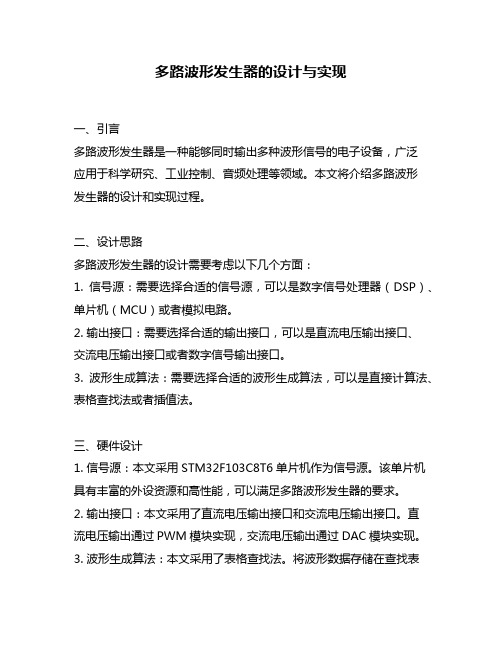
多路波形发生器的设计与实现一、引言多路波形发生器是一种能够同时输出多种波形信号的电子设备,广泛应用于科学研究、工业控制、音频处理等领域。
本文将介绍多路波形发生器的设计和实现过程。
二、设计思路多路波形发生器的设计需要考虑以下几个方面:1. 信号源:需要选择合适的信号源,可以是数字信号处理器(DSP)、单片机(MCU)或者模拟电路。
2. 输出接口:需要选择合适的输出接口,可以是直流电压输出接口、交流电压输出接口或者数字信号输出接口。
3. 波形生成算法:需要选择合适的波形生成算法,可以是直接计算法、表格查找法或者插值法。
三、硬件设计1. 信号源:本文采用STM32F103C8T6单片机作为信号源。
该单片机具有丰富的外设资源和高性能,可以满足多路波形发生器的要求。
2. 输出接口:本文采用了直流电压输出接口和交流电压输出接口。
直流电压输出通过PWM模块实现,交流电压输出通过DAC模块实现。
3. 波形生成算法:本文采用了表格查找法。
将波形数据存储在查找表中,通过查找表的方式实现波形输出。
四、软件设计1. 系统框图:多路波形发生器的系统框图如下所示。
2. 程序流程:(1)初始化:设置时钟、GPIO口、PWM模块和DAC模块等。
(2)生成波形数据:通过表格查找法生成正弦波、方波和三角波等。
(3)输出波形信号:通过PWM模块和DAC模块输出波形信号。
五、实验结果本文设计并实现了一款多路波形发生器。
经过测试,该多路波形发生器能够同时输出正弦波、方波和三角波等多种类型的信号,并且输出精度高,稳定性好。
六、总结本文介绍了多路波形发生器的设计和实现过程。
通过选择合适的信号源、输出接口和算法,可以实现高精度、高稳定性的多路波形发生器。
未来,可以进一步优化算法,增加更多类型的信号输出,并且将其应用于更广阔的领域中。
多种波形发生器课程设计按键电路

多种波形发生器课程设计按键电路一、引言波形发生器是电子工程中常用的一种电路,它可以产生多种不同的波形信号,如正弦波、方波、三角波等。
在电子设计和测试中,波形发生器通常被用来产生标准信号或者测试信号。
本文将介绍多种波形发生器的课程设计,并着重介绍按键电路的设计。
二、多种波形发生器课程设计1. 正弦波发生器正弦波发生器是最基本的波形发生器之一,它可以产生一个连续变化的正弦信号。
在实际应用中,正弦波信号通常被用来作为参考信号或者测试信号。
正弦波发生器的基本原理是利用RC振荡电路来产生一个稳定的振荡频率,并且通过运算放大器对其进行放大。
具体实现方式可以采用集成电路或者离散元件进行搭建。
2. 方波发生器方波发生器可以产生一个由高低两个电平构成的方形脉冲信号。
在数字系统中,方波信号通常被用来表示“0”和“1”两个状态。
方波发生器的基本原理是利用开关电路来控制电路的通断,从而实现高低电平的切换。
具体实现方式可以采用集成电路或者离散元件进行搭建。
3. 三角波发生器三角波发生器可以产生一个由上升和下降两个斜率构成的三角形信号。
在音频系统中,三角波信号通常被用来作为音乐合成的基础信号。
三角波发生器的基本原理是利用积分电路来对方波信号进行积分,从而得到一个连续变化的三角形信号。
具体实现方式可以采用集成电路或者离散元件进行搭建。
4. 锯齿波发生器锯齿波发生器可以产生一个由上升和下降两个斜率构成的锯齿形信号。
在测试系统中,锯齿波信号通常被用来作为测试信号。
锯齿波发生器的基本原理是利用反向比例积分电路来对方波信号进行积分和反向放大,从而得到一个连续变化的锯齿形信号。
具体实现方式可以采用集成电路或者离散元件进行搭建。
三、按键电路设计在波形发生器的实际应用中,通常需要对波形信号进行调节和控制。
按键电路可以实现对波形发生器的控制和调节,使其更加灵活和方便。
按键电路的基本原理是利用开关电路来控制电路的通断,从而实现对波形发生器的控制。
多波形信号发生器设计实验报告

多波形信号发生器设计实验报告一、实验目的本实验的主要目的是设计一款多波形信号发生器,能够输出多种波形信号,并能够通过控制电路对波形进行调节和改变,以满足不同需求。
二、实验原理1. 多波形信号发生器的基本原理多波形信号发生器是一种用于产生不同类型信号的电子设备。
其基本原理是通过控制电路中的各种元器件,如晶体管、电容、电感等,来产生不同类型的信号波形。
常见的波形包括正弦波、方波、三角波等。
2. 信号源在多波形信号发生器中,信号源是最基础也是最重要的部分。
通常使用晶体管或集成电路作为信号源。
其输出频率和振幅可以通过控制元器件来调节。
3. 滤波电路为了保证输出的信号干净稳定,需要在信号源后面加入滤波电路。
滤波电路主要由电容和电感组成,可以滤除杂散噪声以及高频噪声。
4. 放大电路放大电路用于放大经过滤波后的低频部分。
常见放大电路有放大器、运算放大器等。
5. 输出电路输出电路用于将放大后的信号输出到外部设备,如示波器、扬声器等。
常见的输出电路包括隔离式输出和非隔离式输出。
三、实验步骤1. 搭建基本电路将信号源、滤波电路、放大电路和输出电路依次连接起来,形成一个基本的多波形信号发生器电路。
2. 调节元器件通过调节各个元器件的参数,如晶体管的偏置电压、滤波电容和电感的数值等,可以产生不同类型的波形信号。
3. 测试并调整将多波形信号发生器连接到示波器或扬声器上,在不同频率下测试并调整各个元器件,以获得最佳效果。
四、实验结果分析通过实验我们成功地设计出了一款多波形信号发生器,并能够产生多种类型的波形信号。
通过调节各个元器件,我们可以改变输出信号的频率、振幅和相位等参数。
同时,在测试中我们也发现了一些问题,并进行了相应的调整和优化。
五、实验总结与心得体会通过本次实验,我们深入了解了多波形信号发生器的基本原理和构成,掌握了如何设计和调节多波形信号发生器的方法。
同时,我们也意识到了电路设计中的细节问题对最终效果的影响,以及如何通过测试和调整来优化电路性能。
多种波形发生器的设计与制作

课题三 多种波形发生器的设计与制作方波、三角波、脉冲波、锯齿波等非正弦电振荡信号是仪器仪表、电子测量中最常用的波形,产生这些波形的方法较多。
本课题要求设计的多种波形发生器是一种环形的波形发生器,方波、三角波、脉冲波、锯齿波互相依存。
电路中应用到模拟电路中的积分电路、过零比较器、直流电平移位电路和锯齿波发生器等典型电路。
通过对本课题的设计与制作,可进一步熟悉集成运算放大器的应用及电路的调试方法,提高对电子技术的开发应用能力。
1、 设计任务设计并制作一个环形的多种波形发生器,能同时产生方波、三角波、脉冲波和锯齿波,它们的时序关系及幅值要求如图3-3-1所示。
图3-3-1 波形图设计要求:⑴ 四种波形的周期及时序关系满足图3-3-1的要求,周期误差不超过%1±。
⑵ 四种波形的幅值要求如图3-3-1所示,幅值误差不超过%10±。
⑶ 只允许采用通用器件,如集成运放,选用F741。
要求完成单元电路的选择及参数设计,系统调试方案的选取及综合调试。
2、设计方案的选择由给定的四种波形的时序关系看:方波决定三角波,三角波决定脉冲波,脉冲波决定锯齿波,而锯齿波又决定方波。
属于环形多种波形发生器,原理框图可用3-3-2表示。
图3-3-2 多种波形发生器的方框图仔细研究时序图可以看出,方波的电平突变发生在锯齿波过零时刻,当锯齿波的正程过零时,方波由高电平跳变为低电平,故方波发生电路可由锯齿波经一个反相型过零比较器来实现。
三角波可由方波通过积分电路来实现,选用一个积分电路来完成。
图中的u B电平显然上移了+1V,故在积分电路之后应接一个直流电平移位电路,才能获得符合要求的u B波形。
脉冲波的电平突变发生在三角波u B的过零时刻,三角波由高电平下降至零电位时,脉冲波由高电平实跳为低电平,故可用一个同相型过零比较器来实现。
锯齿波波形仍是脉冲波波形对时间的积分,只不过正程和逆程积分时常数不同,可利用二极管作为开关,组成一个锯齿波发生电路。
多种波形发生器_设计论文正稿

《电子技术》课程设计说明书题目名称:多种波形发生器的设计姓名:xxx学号:xxx班级:xxx指导教师:xxx2013年 1 月 4 日摘要波形发生器是一种能够产生大量标准信号和用户定义信号,具有高精度、可重复性、易操作性、对频率、幅值、相移、波形进行动态及时的控制的一类新型信号源。
本设计的设计方案是把滞回比较器和积分器首尾相接组成一个正反馈闭环系统,则比较器输出的方波经过积分器可得到三角波,三角波又触发比较器自动翻转形成法波;三角波—正弦波的转换电路主要由差分放大电路来完成,差分放大电路具有工作点稳定,输入阻抗高,抗干扰能力强等优点。
特别是作为直流放大器,可以有效抑制零点漂移,因此可以将频率很低的三角波变换成正弦波。
波形变换的原理是利用差分放大器传输特性曲线的非线性。
关键词:信号源;滞回比较器;积分器;波形发生器多种波形发生器的设计背景波形发生器是随着众多领域对于复杂的、可由用户定义的测试波形的需要而形成和发展起来的,它的主要特点是可以产生任何一种特殊波形,输出信号的频率、电平以及平滑低通滤波的截至频率也可以作到程序设置,因此在机械性能分析、雷达和导航、自动测试系统等方面得到广泛的应用。
而对AWG的控制、数据传输、输出信号的频率和电平设置都可以通过微机打印口在EPP工作模式下设计完成。
这样不仅具有设计简单,占用微机资源较少的优点,而且操作简单,使用方便,易于硬件升级。
波形发生器是能够产生大量的标准信号和用户定义信号,具有高精度、可重复性、易操作性、连续的相位变换和频率稳定性,还可以对频率、幅值、相移、波形进行动态及时的控制。
随着不断进步的计算机技术和微电子技术在测量仪器中的应用而形成和发展起来的一类新型信号源。
目录1.摘要 (2)1.设计目的 (4)2.设计任务、要求及设计容 (4)2.1任务 (4)2.2要求 (4)2.3设计方案 (5)3. 多种波形发生器原理电路设计 (5)3.1各方案原理框图及论证 (5)3.2电路图和接线图及工作原理 (6)3.3各部分电路设计 (8)3.4 电路的参数选择及计算 (13)3.5电路仿真 (15)3.6系统仿真结果、数据分析和处理结果、报告 (17)3.7 方波---三角波发生电路的实验结果 (19)3.8三角波---正弦波发转换电路的实验结果 (19)3.9 实测电路波形、误差分析及改进方法 (20)4. 仪器仪表明细清单 (20)5.总结 (21)6. 主要参考文献 (21)一、设计目的(1)对波形的产生及与变换电路有关的电子电路知识有大致的理解。
简易多路信号发生器设计报告(含程序、总电路,调试无误)
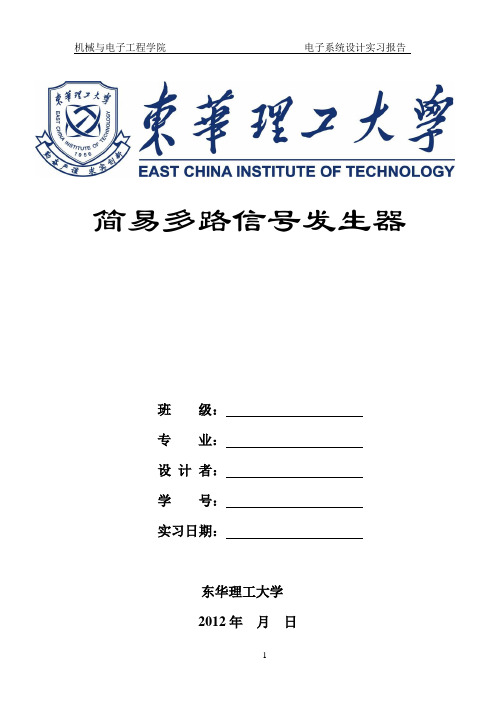
简易多路信号发生器班级:专业:设计者:学号:实习日期:东华理工大学2012年月日简易多路信号发生器摘要:简易多路信号发生器利用单片机控制和DAC0832进行数模转换,通过硬件电路和软件程序相结合,可正弦波、方波、三角波、梯形波及其他任意波形,波形的频率和幅度在一定范围内可改变。
波形和频率的改变通过软件控制,幅度的改变通过硬件实现。
该信号发生器具有体积小、价格低、性能稳定的优点。
多路信号发生器有两个按键,一个按键控制信号类型,按下键一依次改变信号类型和停止产生波形;另一个按键改变信号频率。
一、设计内容及要求:1、设计内容:本课题要求设计一个简易多路信号发生器。
2、设计要求:1.通过单片机控制74LS138译码器,对DAC0832进行片选控制;2.能够产生正弦波、矩形波、锯齿波等基本波形信号,并通过修改程序能够产生任意波形的信号;3.通过两个按键控制波形类型和频率,一个按键控制信号类型,按下键一依次改变信号类型和停止产生波形;另一个按键改变信号频率;4. 有一个LED 显示是否有波形输出;灯亮为有波形输出,灯灭表示无波形输出;二、电路工作原理:电路由单片机最小系统、译码电路、DAC 转换电路、放大输出电路、LED 显示电路、按键组成。
当启动电源时,系统正常工作,通过最小系统控制DAC 转换电路片选信号,正常产生波形信号。
当按下按键1时依次切换输出波形类型和停止转换,按下按键2可在一定频率范围内改变波形频率。
三、选定系统设计方案,画出系统框图四、 单元电路设计参数计算及元器件选择1. 单片机最小系统51单片机最小系统复位电路的极性电容C1的大小直接影响单片机的复位时间,一般采用10~30uF ,51单片机最小系统单片机 89C51按键74LS138 译码电路DAC0832 数模转换电路放大输出电路LED 显示容值越大需要的复位时间越短。
●51单片机最小系统晶振Y1采用11.0592MHz,在正常工作的情况下可以采用更高频率的晶振,51单片机最小系统晶振的振荡频率直接影响单片机的处理速度,频率越大处理速度越快。
- 1、下载文档前请自行甄别文档内容的完整性,平台不提供额外的编辑、内容补充、找答案等附加服务。
- 2、"仅部分预览"的文档,不可在线预览部分如存在完整性等问题,可反馈申请退款(可完整预览的文档不适用该条件!)。
- 3、如文档侵犯您的权益,请联系客服反馈,我们会尽快为您处理(人工客服工作时间:9:00-18:30)。
交通大学电工电子教学基地实验报告实验课程: EDA技术实验名称:多路波形发生器的设计实验台:1号班级:四班学号:08291123 :游振南实验日期:2010年10月24日成绩:一·实验容及其目的:1.熟悉多路发生器的原理还有输出相位差和占空比的原理。
2.熟练用QUARTERII进行电路的编程和仿真。
3.熟练使用IF语句。
二·实验设计思路.1。
多路发生器的原理用分频器而且是可调的因此先设div:integer range 1 to 4;。
通过信号赋值(tmp,tmp1,tmp2)赋给输出信号A,B,C. 通过n改变输出频率。
定义各个变量。
2.。
当resetb=0时,countQ=0;当resetb=1时。
给脉冲时先定义分频比如果countQ < (6*div-1)时countQ <= countQ +1;否者countQ为0。
4.当cltr=01时即H:L=1:1时①如果countQ < 3*div时tmp<=’0’;否者tmp<=’1’②如果countQ < 2*div or countQ>(6*div-2))时tmp1<= '1';否者 tmp1<='0';③如果countQ < div or countQ>(4*div-1)时tmp2<= '0';④否者 tmp2<='1';⑤A等于tmp;B=tmp2;C=tmp3;同理:当cltr=10时即H:L=1:2时当cltr=11时即H:L=2:1时。
其中;公式推导如下:当div=1,cltr=01时当div=2,cltr=01时countQ<6 countQ<12A:0 0 0 1 1 1; A:0 0 0 0 0 0 1 1 1 1 1 1 B:1 1 0 0 0 1; B:1 1 1 1 0 0 0 0 0 0 1 1 C:0 1 1 1 0 0; C:0 0 1 1 1 1 1 1 0 0 0 0 A:countQ<3时tmp=0 A;countQ<6时tmp=0Else tmp=1 Else tmp=1B:countQ<2 or countQ>4时tmp=1 B:countQ<4or countQ>10 ,tmp=1 Else tmp=0 Else tmp=0C:countQ<1 or countQ>3时tmp=0 C: countQ<2 or countQ>7时tmp=0 Else tmp=1 Else tmp=1同理:cltr=10,cltr=11.当cltr=01时if(countQ < 3*div) then tmp<= '0';else tmp<='1';if(countQ < 2*div or countQ>(6*div-2)) then tmp1<= '1';else tmp1<='0';if(countQ < div or countQ>(4*div-1)) then tmp2<= '0';else tmp2<='1';当cltr=10时if(countQ < 4*div) then tmp<= '0';else tmp<='1';if(countQ < 2*div ) then tmp1<= '1';else tmp1<='0';if(countQ < 2*div or countQ>(4*div-1)) then tmp2<= '0'; else tmp2<='1';当cltr=11时if(countQ < 2*div) then tmp<= '0';else tmp<='1';if(countQ < 2*div or countQ>(4*div-1)) then tmp1<= '1';else tmp1<='0';if(countQ < 4*div ) then tmp2<= '1';else tmp2<='0';将信号tmp 赋给A ; tmp1 赋给B ; tmp2 赋给 C ;三·流程图:四·程序及仿真波形:library ieee;use ieee.std_logic_1164.all;use ieee.std_logic_arith.all;use ieee.std_logic_unsigned.all;entity boxing isport(clk,resetb: in std_logic;cltr:in std_logic_vector(1 downto 0); div:integer range 1 to 4;A,B,C:out std_logic);end boxing;architecture a of boxing issignal countQ: integer range 0 to 255; signal tmp:std_logic;signal tmp1:std_logic;signal tmp2:std_logic;beginprocess(clk,resetb)beginif clk'event and clk='1' thenif (resetb='0') thencountQ<=0;elseif( countQ < (6*div-1)) thencountQ <= countQ +1;else countQ <=0;end if;end if;end if;end process;process(cltr,countQ)beginif(cltr=01) thenif(countQ < 3*div) thentmp<= '0';else tmp<='1';end if;if(countQ < 2*div or countQ>(6*div-2)) then tmp1<= '1';else tmp1<='0';end if;if(countQ < div or countQ>(4*div-1)) then tmp2<= '0';else tmp2<='1';end if;end if;if(cltr=10) thenif(countQ < 4*div) thentmp<= '0';else tmp<='1';end if;if(countQ < 2*div ) thentmp1<= '1';else tmp1<='0';end if;if(countQ < 2*div or countQ>(4*div-1)) then tmp2<= '0';else tmp2<='1';end if;end if;if(cltr=11) thenif(countQ < 2*div) thentmp<= '0';else tmp<='1';end if;if(countQ < 2*div or countQ>(4*div-1)) then tmp1<= '1';else tmp1<='0';end if;if(countQ < 4*div ) thentmp2<= '1';else tmp2<='0';end if;end if;end process;A<=tmp;B<=tmp1;C<=tmp2;end a;仿真图:div=1,cltr=01时div=1,cltr=10div=1,cltr=11div=2,cltr=01div=2,cltr=10div=2,cltr=11div=3,cltr=01div=3,cltr=10div=3,cltr=11div=4,cltr=01div=4,cltr=10div=4,cltr=11五·实验中遇到的问题及解决步骤1.定义div为变量?div:integer range 1 to 42.占空比原理?通过网络查找相关定义和通过网络和图书馆查找6分频分频器汇编中设定占空比推出相关频率的占空比。
3.通过控制div(1~4)改变输出相应得分频?开始时只能编写6分频的分频器无法通过改变div改变输出频率。
通过助教老师的讲解通过设置div为变量把六分频分频器中的公式变换即可。
4.A,B,C,输出三路相位差120的意思?通过网上查找A,B,C 输出三路占空比一样延迟2/3T(T:分频后的周期)。
5.Process()中应该填写什么?开始时不知道填写什么。
后来通过看书中的程序知道里面填写的是要输入的信号。
.6.A,B,C通过什么控制三路相差120度?首先想到通过控制时间延迟为20ns和40ns发现如果clk一个脉冲时间变化就会导致波形不一样而且分频不一样导致延迟时间不一样。
然后想到通过一个一个的把波形用高低电平。
通过给一个脉冲,控制cltr,div观察输出A,B,C的电平可是编写这样太麻烦了。
后来通过观察A,B,C每一个脉冲的输出电平找出其规律通过公式编写从而使汇编变得简单些。
